The Significance of the Ant Colony Queen
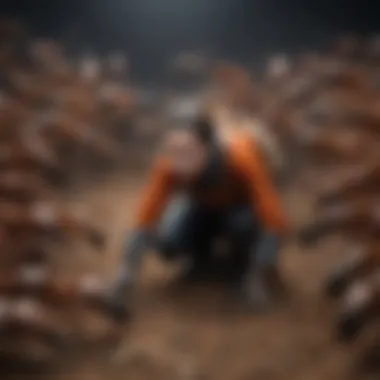

Intro
The complexity of ant societies presents a fascinating area of study within entomology. Among the various members of an ant colony, the queen holds a unique and pivotal position. This article aims to uncover the significance of the ant colony queen, exploring her biological and social roles, reproductive strategies, and her influence on the development and sustainability of the colony. By analyzing these aspects, we can gain a better understanding of the larger ecological implications of ant behavior and organization.
Ant colonies are comprised of many individuals, each with assigned roles. The queen, however, serves as the central reproductive figure, responsible for the survival and growth of the entire colony. The interaction between the queen and other members, such as workers and drones, shapes the dynamics of the colony, affecting its structure and function. By examining these relationships, we illuminate the queen’s integral part in maintaining the delicate balance of the colony.
As we delve into the lifecycle and reproductive habits of the queen, it becomes clear that she is more than just a passive figure. Her ability to produce thousands of offspring is crucial for the colony's expansion and genetic diversity. The implications of her reproductive strategies are far-reaching and warrant a closer look, especially within the context of environmental challenges ants may face.
In this article, we will discuss key findings regarding the queen's role, the methodology utilized to study her behaviors, and the relevance of this research in current scientific discussions. The insights gathered not only enhance our understanding of ant societies but also provide a broader perspective on social insects and their ecological environments.
"The ant colony queen is more than just a leader; she is the linchpin that ensures the colony's future through her reproductive capabilities and social interactions."
We will explore these themes in greater detail, highlighting the queen’s overall significance in the thriving world of ants.
Prolusion to Ant Societies
Understanding ant societies is crucial for grasping the role of the queen within these complex living structures. Ants exemplify one of the most sophisticated forms of social organization in the animal kingdom. This complexity is not merely fascinating, but it holds significant implications for ecological studies, evolutionary biology, and even human social behavior. In this article, we will explore how the dynamics of ant colonies function, and the pivotal role that the queen plays within this functioning society.
Defining Ant Colonies
Ant colonies are defined as organized groups of individual ants, operating under a cooperative social structure. Each colony can often be seen as a single entity that functions harmoniously through division of labor, communication, and shared responsibilities. Typically, ant colonies consist of three distinct castes: the queen, worker ants, and male ants.
- The Queen: The central figure whose primary role is to reproduce. Depending on the species, there can be one or multiple queens in a single colony.
- Worker Ants: These are sterile females. Their tasks vary widely, including foraging for food, caring for the queen's offspring, and defending the nest.
- Male Ants: Usually present only for mating purposes, they die shortly after reproduction.
Ant colonies demonstrate various types of structures and can range in size from mere dozens to millions of individuals, all functioning towards common goals. The survival and success of these colonies are heavily reliant on their social structures and roles, especially that of the queen.
Importance of Social Structures
The significance of social structures in ant colonies cannot be overstated. It is these structured relationships that determine how efficiently a colony can function and respond to environmental challenges. Understanding these social systems offers insights into the evolutionary significance of cooperation in animals. Below are key aspects:
- Cooperative Behavior: Through teamwork, worker ants perform complex tasks that would be impossible for individuals. This cooperation enhances survival.
- Communication: Ants communicate through pheromones, sounds, and touch to relay messages about food sources, dangers, or changes in the environment.
- Resource Management: Well-defined roles within the colony help optimize foraging and resource allocation, ensuring that energy is not wasted.
A balanced social structure directly influences productivity, which, in turn, has ecological implications, such as soil aeration and seed dispersal. Thus, the structure of ant societies showcases intricate dynamics that are fundamentally important for their survival and ecological roles in ecosystems.
The Queen Ant: A Central Figure
The queen ant serves as a cornerstone in the structure and function of an ant colony. Her presence influences not only the reproductive capabilities of the colony but also its social organization. As the primary individual responsible for laying eggs, her biological role ensures the continuous growth and sustainability of the colony. Each queen's survival and health directly impact the overall vitality and functionality of her community.
Biological Role of the Queen
The biological role of the queen ant is multifaceted and crucial for the colony's longevity. Typically larger than worker ants, the queen's primary purpose is reproduction. In many species, a queen can live for years, while workers have much shorter lifespans.
When a new colony is established, the queen begins her life by mating during a nuptial flight. After mating, she returns to the ground to start a new colony. This is a critical moment, as the queen will not have any workers at first; she must start everything from scratch. Her initial task involves laying fertilized eggs, which will eventually develop into worker ants.
In addition to reproduction, the queen also emits pheromones that play a vital role in colony dynamics. These chemical signals maintain harmony within the colony. If the queen's health declines, or if she stops producing pheromones, the colony may start to falter due to confusion or a lack of directive behavior among the workers.
Distinctions Among Queen Ants
Queen ants are not uniform; they exhibit various distinctions based on species, reproductive strategies, and social structures.
For example, some ant species have multiple queens in a single colony, while others maintain a monogynous structure, relying on a single queen for all reproductive tasks. The form and behavior of queens also vary. Some, such as the leafcutter ant queen from the Atta genus, can attain significant sizes, while other species have much smaller queens.
Differences also arise in mating practices. In some species, queens mate only once, thereby storing sperm to fertilize eggs over several years. In contrast, some may mate multiple times, which helps ensure genetic diversity within their colony. This genetic variability can enhance the colony's resilience against diseases and environmental changes.
In essence, the variations among queen ants highlight the intricate adaptations these figures have developed to secure the survival and efficiency of their colonies. Understanding these distinctions brings further insights into the complex social dynamics inherent in ant communities.
Lifecycle of the Queen Ant
Understanding the lifecycle of the queen ant is essential to grasp her pivotal role within an ant colony. This cycle not only informs us about her biological functions but also highlights the strategic importance of her development and survival. The queen's lifecycle encompasses several distinct stages, each critical for ensuring the colony thrives. Moreover, comprehending these stages contributes to our knowledge of ant colony dynamics and social structures.
Development Stages
The lifecycle of a queen ant typically includes several developmental stages: egg, larva, pupa, and adult. After mating, the fertilized queen ant lays the eggs in a suitable environment. During the egg stage, the eggs are generally small and white, taking a few days to hatch. Once hatched, they enter the larval stage where they feed and grow; this stage can take several weeks. The larvae are fed by worker ants, which means the success of this stage heavily relies on the workers' efficiency and care.
Next is the pupal stage, where larvae undergo metamorphosis. In this stage, larvae transform into adult ants, a process that may last from a few weeks to months, depending on the species and environmental conditions. Upon emerging as adults, the queen's role evolves significantly. While the newly emerged queen usually focuses on reproduction, worker ants are present to assist in her transition into a functional role within the colony.
Challenges During Development
Queens face numerous challenges throughout their lifecycle. One significant challenge is the initial stage of development when the queen must find a suitable place to establish a new colony. Environmental factors such as temperature, humidity, and food availability can all impact the success of this transition.
Another challenge is predation. During their developmental stages, queen ants can fall victim to various natural predators. Birds, other insects, and even some vertebrates often target them due to their size and relative immobility during certain lifecycle stages. Additionally, if a queen’s colony is established, competition with neighboring colonies can lead to stress on resources, which impacts growth and health.
Reproductive Habits of the Queen
The reproductive habits of the queen ant are a crucial aspect of her role within the colony. Understanding these habits offers insight into how the survival and growth of ant colonies are ensured. The queen's reproductive practices directly affect the population dynamics, social structure, and overall health of the colony.
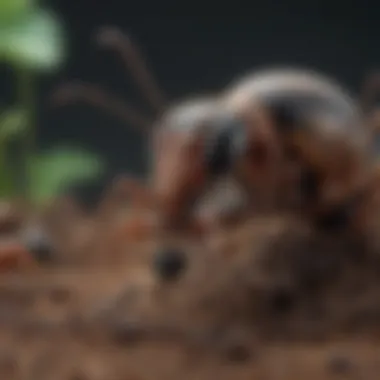
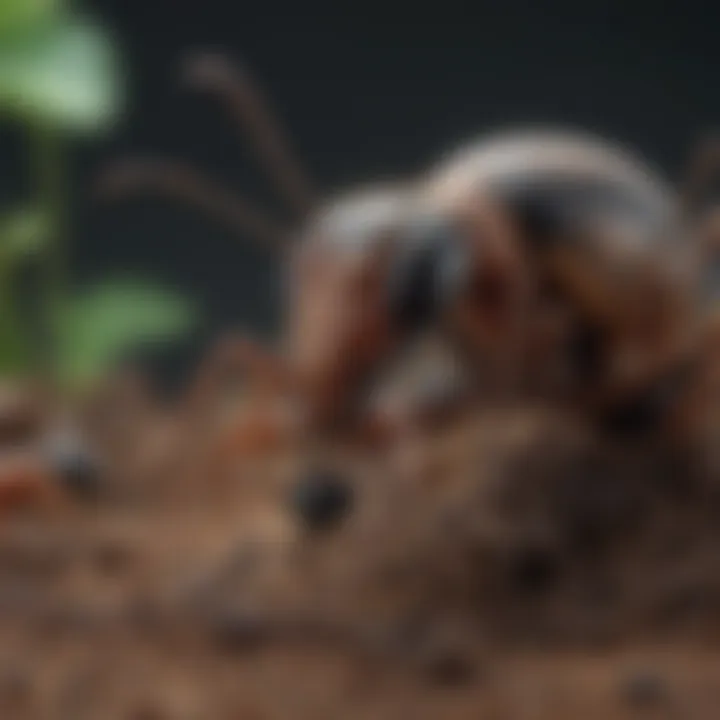
Mating Practices
Mating is a pivotal event in the life of a queen ant. Most species engage in a reproductive strategy that includes a single nuptial flight. During this flight, virgin queens and male ants leave their respective colonies to mate. This usually occurs during a specific period when environmental conditions are optimal for reproductive activities.
- Timing: The timing of nuptial flights can vary by species and is often influenced by environmental factors such as temperature and humidity. Kings are typically attracted to pheromones released by the queens, which signal readiness to mate.
- Copulation: After mating, which lasts several hours, the male usually dies soon after. The queen collects sperm during this mating event and can store it for extended periods. This storage is essential as it allows her to fertilize eggs throughout her lifetime without the need to mate again.
The mating practices of the queen are not just reproductive actions but are also about establishing genetic diversity within the colony. The variety of males allows for a broader genetic pool, which is crucial for the adaptability and resilience of the colony.
Egg-Laying Dynamics
Once mated, the queen returns to her nest to begin the process of egg-laying. This phase is critical for the establishment and growth of the colony.
- Initial Egg Laying: The queen will lay her first batch of eggs shortly after returning. These eggs develop into worker ants that will assist in building the colony and caring for subsequent generations. The egg-laying rate can vary from species to species, with some queens capable of laying thousands of eggs per day.
- Nurturing and Care: The queen does not physically care for the eggs or larvae; instead, worker ants are responsible for the nurturing. This division of labor is vital for the efficient functioning of the colony. The presence of the queen influences the workers' behavior, ensuring they prioritize the care of her offspring.
The queen’s prolific egg-laying capability underscores her integral role in sustaining ant colonies. Her productivity can determine the colony’s success in various environments.
Interaction with Colony Members
The interaction between the queen ant and other colony members is crucial for the overall health and efficiency of the ant society. These relationships bind the colony together and promote various functions that sustain life and survival within the group. Each interaction serves specific purposes and reinforces the complex social structure that characterizes ant colonies. Understanding this dynamic is essential, as the queen influences both worker ants and drones in ways that ultimately enhance colony performance.
Relationship with Worker Ants
The queen’s relationship with worker ants is foundational. Worker ants are responsible for foraging, caring for larvae, and maintaining the nest. They also serve as the primary defense against potential threats. The queen ant plays a pivotal role in regulating these workers through pheromones, which are chemical signals that influence their behavior and activity.
These pheromones not only promote a sense of unity and coordination among workers but also help in managing their reproductive behaviors. For instance, the queen produces specific pheromones that suppress the reproductive capabilities of worker ants, ensuring that they focus on the colony's collective survival rather than individual reproduction. Thus, the queen is seen not just as a reproducer but as a vital leader.
Moreover, the workers, in return, exhibit a level of caretaking behavior towards the queen. They feed her and maintain her environment, contributing to her well-being and longevity. This mutual support solidifies the colony’s hierarchy and reinforces the dependency that ant species exhibit in their social structures. It's a balance where the well-being of the queen ensures the overall health of the colony.
Role in Colony Communication
Communication within an ant colony is multi-faceted, involving the use of pheromones, touch, and sound. The queen ant plays a central role in this communicative web. Her release of various pheromones not only informs workers about her reproductive status but also can signal the need for certain actions based on environmental cues.
For example, a colony under threat might experience an increase in alarm pheromones, prompting more aggressive behavior among workers. In contrast, the queen’s pheromones might signal a stable and thriving colony, encouraging reproductive activities among other workers when conditions are favorable.
Furthermore, the queen’s presence can be a calming influence within the colony. When the queen is healthy and actively producing eggs, workers tend to function optimally, maintaining high levels of efficiency in foraging and brood care. The stability her pheromones provide helps manage the stress levels among workers, thereby enhancing their productivity.
Research indicates that the effectiveness of a queen's pheromonal communication is integral to a colony’s adaptability and survival.
Hierarchical Structure in Ant Colonies
Understanding the hierarchical structure in ant colonies is critical for appreciating how these complex societies function. The queen ant holds a prominent position within this hierarchy. This role is not just ceremonial; it is crucial for the reproductive success and overall stability of the colony. The hierarchy establishes defined roles and responsibilities, ensuring the colony operates efficiently.
Position of the Queen in the Hierarchy
The queen is at the apex of the colony's social structure. Her primary function is reproduction. She produces the majority of the colony's offspring, allowing for continuity and growth. This position is significant because it influences the entire colony's dynamics. Worker ants and drones rely on the queen for their roles. A healthy queen leads to a strong colony, while a distressed or absent queen can result in chaos and eventual collapse.
In terms of social ranking, the queen is not just a leader; she acts as the central figure of the colony. Her pheromones play an essential role in communication, signaling to worker ants about her presence and health. This chemical signaling helps maintain order and cohesion among colony members.
Comparison of Roles - Queen vs. Workers
Queens and workers serve distinct roles within the ant colony, each vital for its survival. While the queen focuses on reproduction, the worker ants handle various tasks that contribute to the colony's daily operations. Workers forage for food, care for the young, and maintain the nest.
- Reproductive Focus: The queen's primary responsibility is to reproduce. She lays thousands of eggs during her lifetime, ensuring the colony's growth.
- Nurturing the Colony: In contrast, worker ants nurture the queen's offspring. They assist in feeding and protecting the larvae.
- Task Specialization: Worker ants also display specialization depending on their size and age, taking on different tasks over time.
"In an ant colony, the queen is not merely a ruler but a vital element that ensures the continuation of the community."
This dynamic between the queen and worker ants highlights the efficiency and organization found in ant societies. This structure serves as a foundation for understanding how social insects operate and adapt to environmental pressures.
Such a hierarchical system illustrates the interdependence of roles and emphasizes the significance of each member's function in sustaining the colony.
Ecological Importance of the Ant Queen
The ecological significance of the ant queen extends beyond her immediate role in the colony. She is essential for the growth, sustainability, and overall health of her colony. The queen's productivity directly supports the vast social structure of the ant community. Understanding her ecological importance sheds light on ant behavior and their impact on various ecosystems.
Impact on Colony Growth and Stability
The queen's ability to reproduce is fundamental to sustain the colony. The rate at which she lays eggs can influence the entire colony's population dynamics. A healthy, prolific queen ensures that there is a consistent influx of workers, which is vital for colony maintenance and expansion. This relationship can affect a multitude of factors, including:
- Worker Production: The number of workers determines how effectively a colony can forage and care for the young, impacting resource acquisition.
- Colony Resilience: When a queen is healthy and active, the colony can better withstand environmental stresses, such as food shortages or habitat loss.
- Resource Allocation: The queen's health influences how a colony allocates its resources, including energy devoted to reproduction versus colony upkeep.
The colony's growth is also linked to the timing of new colonies being established. During the nuptial flight, the queen mates and then seeks a new site to establish a nest. Thus, her health directly affects the colony stability and potential for future generations.
Role in Ecosystem Dynamics
The role of the ant queen in ecosystem dynamics is profound. Ants are considered keystone species in many environments, meaning their presence significantly impacts ecological balance. The queen's activity contributes to various ecological functions, primarily through her influence on:
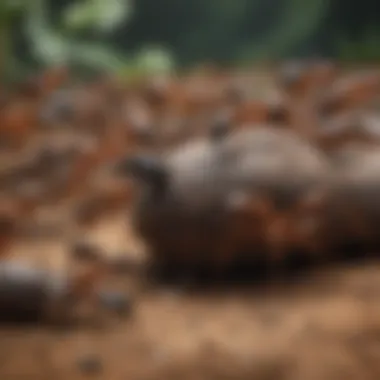
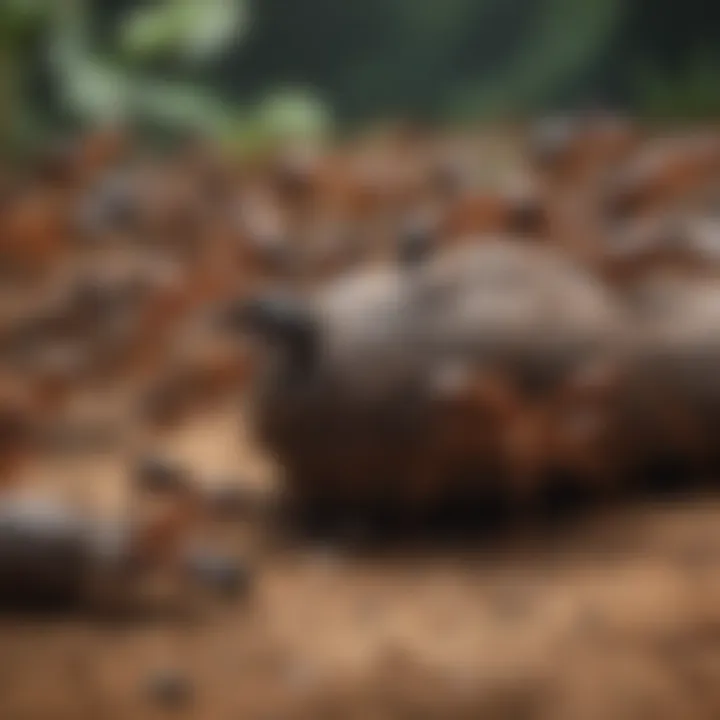
- Soil Aeration: Ants excavate tunnels, enhancing soil structure, oxygenation, and nutrient cycling. This can lead to improved plant growth in surrounding areas.
- Seed Dispersal: Some ant species engage in seed harvesting and dispersal, which aids in plant propagation and biodiversity.
- Decomposition: Ants contribute to breaking down organic materials, supporting nutrient availability in their habitats.
In summary, while the queen is an integral part of her colony, her ecological contributions resonate throughout the environment. Her presence ensures that ant colonies flourish, which in turn supports overall biodiversity and ecosystem function.
The health of an ant colony, initiated and sustained by the queen, plays a critical role in maintaining the ecological equilibrium, affecting both the colony and broader environmental contexts.
Colony Survival Strategies
Understanding colony survival strategies is crucial in grasping how ant colonies endure various challenges in their environments. The queen plays a significant role in orchestrating these strategies by influencing the behaviors and roles of worker ants. This section discusses the queen's adaptations and the colony's response to environmental changes, highlighting their importance in sustaining the colony's viability.
Adaptations of the Queen
The adaptations of the queen ant are essential for ensuring the success of the colony. Primarily, the queen is equipped with morphological and behavioral traits that promote efficiency in her responsibilities.
- Morphological Characteristics: The queen's larger size compared to worker ants facilitates egg production. Her wings, although typically shed after mating, show her capacity to disperse and establish new colonies.
- Physiological Adaptations: The queen possesses a highly developed reproductive system, allowing her to produce thousands of eggs throughout her lifetime. This reproductive prowess is vital for maintaining population stability within the colony.
- Chemical Communication: The queen releases pheromones that regulate colony behavior. These chemical signals coordinate the activities of worker ants, ensuring tasks toward food gathering, care of brood, and nest maintenance are executed efficiently.
These adaptations not only help the queen fulfill her reproductive role but also contribute to the colony's overall resilience against environmental pressures and threats, ensuring survival over generational cycles.
Response to Environmental Changes
Ant colonies face numerous environmental changes, including shifts in temperature, availability of resources, and the presence of predators. The queen's adaptability to these changes is a determining factor for colony survival.
- Thermal Regulation: Many ant species demonstrate behaviors such as relocating brood or adjusting foraging patterns based on temperature changes. The queen, by managing these pheromonal signals, aids in reducing the risk of heat distress.
- Resource Allocation: In times of scarcity, the queen may regulate reproduction rates. By slowing down egg-laying during adverse conditions, she helps maintain the existing workforce's health and ensures the colony's self-preservation until conditions improve.
- Colony Structure Adjustment: Some colonies may alter their social structure in response to environmental changes. Queens can collaborate with their worker ants in organizing the colony to optimize foraging strategies while minimizing risks posed by predators or competitors.
"Adaptability is crucial for the survival of ant colonies, and the role of the queen is central to this ability."
Overall, the coordinated efforts of the queen and workers in response to environmental changes enhance not only the immediate survival of the colony but also its long-term sustainability.
Threats to Queen Ants and Colonies
Understanding the threats to queen ants and their colonies is critical in appreciating their role within ecosystems. Queen ants represent the foundation of their communities, guiding population growth and stability. However, several factors jeopardize their existence and, by extension, the survival of their colonies. Identifying these threats is crucial for both ecological research and conservation efforts.
Natural Predators
Predation is a significant challenge faced by queen ants. Various predators pose risks to queen ants, especially during nuptial flights and when they establish new nests.
- Birds: Some bird species are adept at spotting and catching queen ants during their mating swarms.
- Mammals: Larger mammals, including rodents, may raid nests for both queen ants and larvae.
- Other insects: Certain predatory insects, such as wasps and spiders, also target queen ants, either when they are vulnerable or in the process of forming new colonies.
These predators exert pressure on ant populations and influence reproduction rates. The presence of natural predators can lead to increased mortality rates among queens, affecting the overall colony structure and functionality.
Human Impact on Habitats
Human activities also have profound effects on the survival of queen ants and their colonies. Habitat destruction, pollution, and climate change result in significant threats.
- Habitat Destruction: Urbanization and agricultural expansion reduce natural habitats for queen ants. Deforestation leads to less suitable nesting sites, limiting the queen's ability to found new colonies.
- Pesticides: The use of chemicals in agriculture can directly kill queen ants and indirectly affect their health through food chain contamination.
- Climate Change: Alterations in climate patterns impact food availability and nesting conditions. Extreme weather events can destroy colonies, further threatening the queen's survival.
Such human-driven changes in the environment emphasize the need for protective measures to support queen ants and their ecosystems. These efforts could involve conservation strategies and more sustainable agriculture practices aimed at reducing habitat loss and pollution.
"The integrity of ant colonies hinges not only on the queen's survival but also on the health of their ecosystems."
Awareness of these threats encourages a deeper understanding of the dynamics within ant societies and highlights the importance of preserving their natural habitats. The role of the queen ant extends beyond her immediate colony; it is integral to broader ecological networks.
Research and Studies on Queen Ants
The study of queen ants is critical to understanding the complexities of ant societies. The queen's role extends beyond reproduction; she is at the center of social organization and ecological interactions within her colony. Discovering the nuances of her function offers insights into evolution, behavior, and environmental adaptations of social insects. Continuous research contributes to current knowledge and can inform conservation efforts and ecological planning. Heightened awareness of ant colonies' health can directly affect ecosystem stability, given ants' integral role in soil aeration, seed dispersal, and organic matter breakdown.
Current Research Trends
Research in the field is evolving, with various focus areas gaining prominence. Key trends include:
- Genetic Studies: Scientists are examining the genetic variation within queen populations. This research aims to understand how genetics affect reproductive success and colony resilience. Genetic mapping reveals relationships between queen traits and environmental adaptability.
- Behavioral Ecology: There is growing interest in how queens interact with worker ants. Studies illustrate that queens do not merely lay eggs; their behaviors influence colony dynamics. Observing interactions sheds light on communication and social hierarchy.
- Impact of Climate Change: Researchers explore how global warming affects the reproductive success and survival of queen ants. Changes in temperature and habitat may impact queen longevity and the timing of nuptial flights. Understanding these impacts is vital as they indicate broader ecological shifts.
"Through comprehensive research, we gain a clearer picture of how queen ants navigate their essential roles within the colony and the ecosystem."
Future Directions in Ant Studies
Looking forward, the path for ant research is becoming clearer:
- Advanced Technology: The integration of technology such as drones and remote sensing can improve data collection on ant behavior and environments. These methodologies allow for large-scale studies that were previously difficult to conduct.
- Climate Resilience Studies: Future research must focus on how queen ants will adapt to changing climates. Long-term studies will be essential to predict colony responses and survival strategies.
- Interdisciplinary Approaches: A growing trend is the incorporation of insights from different scientific fields. Collaboration with ecologists, geneticists, and climate scientists can provide a holistic understanding of ant dynamics.
- Public Engagement: Involving the public in citizen science initiatives can increase data collection and awareness. This engagement ensures broader support for ant conservation.
Studying queen ants contributes vital knowledge to both science and ecology. As research evolves, so too does the understanding of the delicate balance in ecosystems that these fascinating insects inhabit.
The Role of Technology in Ant Research
Technology plays a critical role in furthering our understanding of ant colonies, particularly regarding the queen's significance within these societies. With advancements in various fields, researchers are able to observe, analyze, and document behaviors and interactions that were previously difficult to study. This section will discuss

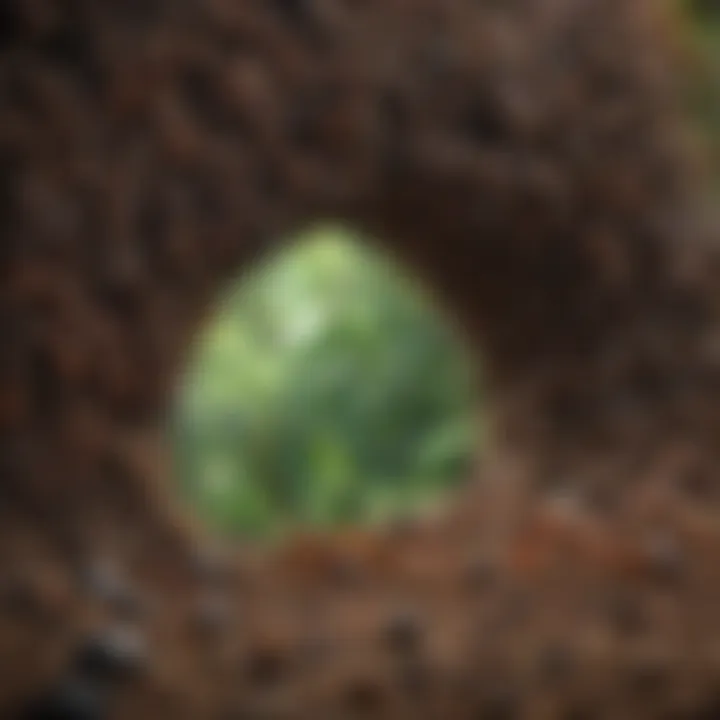
- The impact of technological advancements on ant research.
- Specific tools and methods enhancing the study of ant queens.
- The implications for science and ecological understanding regarding ant colonies.
Advancements in Observation Techniques
Recent improvements in observation techniques have revolutionized the way scientists study ant behaviors. High-resolution cameras, for example, enable detailed monitoring of social interactions within colonies. These cameras can record continuously, capturing nuanced behaviors and interactions between the queen and her workers. Additionally, the use of infrared and thermal imaging allows researchers to study ant activity patterns without disturbing the colony. This non-invasive approach yields more authentic data on how queens interact with worker ants and their environment.
A notable advancement is the application of video tracking technology. This software analyzes movement patterns and social dynamics in real-time. Researchers can now quantify aspects of the queen's influence on her colony more accurately than ever before. The data collected can be used to develop models that predict how changes in queen behavior might impact the entire colony.
Moreover, the utilization of drones for aerial surveillance provides a broader perspective on colony behavior. Observing colonies from above aids in understanding their foraging patterns and territorial behaviors. All these enhanced observation techniques serve to deepen our understanding of the role of the queen ant in her colony.
Molecular Studies and Genetic Research
Molecular technologies are key to unlocking the genetic mysteries surrounding ant queens. Genetic analysis enables researchers to explore the hereditary aspects influencing a queen’s reproductive success and lifespan. By sequencing DNA from various ant species, scientists can identify the genes associated with traits that aid the queen in fulfilling her role effectively.
The study of pheromones, coded in the ants' genetic material, allows researchers to understand how queens communicate within their colonies. Queens release specific pheromones that signal her presence and reproductive status, which directly influences worker behavior. Techniques such as CRISPR gene editing are also paving the way for experimental studies that dissect the genetic foundations of behaviors linked to queen ants.
Additionally, genetic research helps reveal how environmental changes affect genetic diversity within colonies. This understanding is crucial given the ongoing threats to habitats. Protecting genetic diversity ensures not just the survival of the queen but also the overall resilience of the colony.
"The integration of technology in ant research is not just about enhancing data collection; it's about reshaping our understanding of complex social structures in nature."
With all these advancements ultimately providing more profound insights into ant colonies, it is clear that technology not only aids researchers but also contributes significantly to conservation efforts and ecological studies. The role of technology in ant research underscores the importance of continuous innovation in understanding social insects like the ant queen.
Ant Colonies and Climate Change
Ant colonies play a crucial role in ecosystems, and their survival is significantly influenced by climate change. This section examines how rising global temperatures, shifts in precipitation patterns, and other climate-related factors impact the behavior and dynamics of ant colonies. The queen ant stands at the center of these changes, as her well-being directly affects the entire colony. Understanding this relationship is essential for researchers and environmental conservationists. Not only do changes in climate alter the habitat of ants, but they also impact their social structures, reproductive success, and survival strategies. In essence, climate change acts as a complex stressor that challenges the stability of ant colonies.
Effects of Temperature on Colony Behavior
Temperature fluctuations can significantly impact ant behavior, affecting foraging patterns, communication, and overall colony activity. A warming climate may lead to earlier mating seasons and influence the timing of resource gathering. Queens might adjust their reproductive cycles based on temperature, prompting them to produce more or fewer eggs. For instance, some studies indicate that increased heat can enhance egg-laying but may stress worker ants, reducing their efficiency.
Additionally, behavioral responses vary across ant species. For example, species like the Formica rufa may become more aggressive in warmer conditions, while others may retreat. Workers may change their foraging locations to optimize food collection amid shifting ecological conditions. These temperature-induced changes reveal the adaptability of ant colonies but also highlight their vulnerability to extreme weather events.
Adaptation Mechanisms in Ant Queens
Adaptation mechanisms in ant queens are vital for the survival of the colony. Queens exhibit several strategies to cope with the challenges presented by climate change. One primary mechanism involves behavioral plasticity, which allows queens to alter their reproductive output based on environmental conditions. For example, if food sources become scarce due to heat waves, a queen may reduce the number of eggs she lays, ensuring that workers can sustain the colony without depleting resources too rapidly.
Furthermore, queens can adjust the timing of their nuptial flights, synchronizing with optimal weather conditions. This strategic mating approach ensures a higher chance of reproduction success. Genetic diversity within colonies can also be enhanced through mating with multiple males, which may improve the colony's resilience to changing conditions. As environmental conditions evolve, the queen’s ability to adapt is crucial for maintaining colony health and stability. Ultimately, these mechanisms are not only essential for the survival of the individual colonies but also play a significant role in ecosystem health.
The Future of Ant Colonies
The significance of understanding the future of ant colonies lies in their ecological roles and the broader implications of their survival. As climate change and habitat destruction threaten many species, ant colonies serve as indicators of environmental health. Their adaptability often reflects changes in their environments. Thus, examining the future of ant colonies offers valuable insights into ecosystem dynamics.
Predictions for Colony Dynamics
Ant colonies are complex entities, and their dynamics can vary significantly in response to environmental changes. Considering various factors, scientists predict that the interactions within colonies may shift as climatic conditions evolve. For instance, species like the Carpenter Ant (Camponotus) might adapt differently compared to Leafcutter Ants (Atta).
- Changing Temperature: A rise in average temperatures may alter reproductive cycles, leading to earlier mating seasons for some queen ants.
- Resource Availability: Fluctuations in food resources due to climate change can impact the foraging strategies of worker ants, potentially influencing the queen's reproductive output.
- Predation Pressure: Increased predation from other species may force colonies to adapt their defensive behaviors, establishing new hierarchies within their social structure.
These predictions underscore the necessity of ongoing research to understand the resilience and adaptability of ant colonies in a rapidly changing world.
Conservation Efforts and Impacts
Ants play a pivotal role in ecosystems. Therefore, concerted conservation efforts are crucial. These actions can mitigate impacts from human activities and environmental changes.
- Habitat Preservation: Protecting habitats is vital. Preservation of areas like old growth forests or grasslands, where diverse ant species thrive, is critical.
- Sustainable Practices: Encouraging sustainable agricultural practices helps balance the needs for food and the protection of ant ecosystems.
- Public Awareness: Raising awareness of the ecological importance of ants can empower local communities to take action to protect these species.
Effective conservation strategies not only benefit ant colonies but also promote overall biodiversity within ecosystems.
By focusing on these conservation efforts, stakeholders can help ensure that ant colonies continue to thrive, offering insights into the resilience of nature amidst global challenges. The path forward is complex, but by prioritizing these strategies, there is potential for positive outcomes for both ants and their habitats.
Ending
By summarizing key points, we see specific elements emerge. First, the biological framework of queen ants underscores their unique physiological adaptations for reproduction. Second, the relationship between the queen and worker ants showcases the complexity of ant societies, emphasizing cooperation and communication as vital functions. Lastly, it is evident that queens face numerous challenges, both internal and external, which directly influence the colony's stability and adaptability to environmental shifts.
Moreover, recognizing these dimensions benefits our understanding of biodiversity and ecological health. As the queen's role intersects with environmental factors, addressing the challenges she faces can inform conservation efforts. Elevated awareness can lead to more effective strategies aimed at preserving ant colonies and, by extension, their ecosystems. Therefore, the importance of this topic lies not only in academic interest but also in practical implications for future ecological studies.
Summary of Key Points
To encapsulate the findings, the following key points provide clarity on the queen's significance within ant colonies:
- The queen's primary function revolves around reproduction, influencing genetic diversity.
- Her interactions with worker ants highlight vital social structures and roles within the colony.
- Ecologically, queens are pivotal in maintaining the balance of ecosystems through their contributions to population dynamics in various environments.
- Research into queen ants offers insights into the broader realm of social insects and their environmental significance.
Implications for Future Research
Future research on ant colony queens is crucial for several reasons. First, exploring genetic and behavioral aspects can uncover how queens adapt to changing environments, particularly as global temperatures rise. Additionally, investigating the social dynamics between queens and worker ants can enhance our understanding of cooperative behavior in social insects.
Innovative technologies—like molecular genetic analysis and advanced observation techniques—should drive new inquiries. For instance, how does the presence of a queen influence worker ant behavior across different species? Further studies may also consider the impact of urbanization and habitat loss on queen survival. Such inquiries will deepen our comprehension of insect societies and inform conservation measures that protect these intricate life forms.
"Studying the ant queen not only illuminates the interconnectedness of species but also emphasizes the fragility of their ecosystems and the urgency of preservation strategies."
Through ongoing exploration, researchers will better grasp the nuanced roles of queens in ant colonies and their relevance to ecological frameworks.



